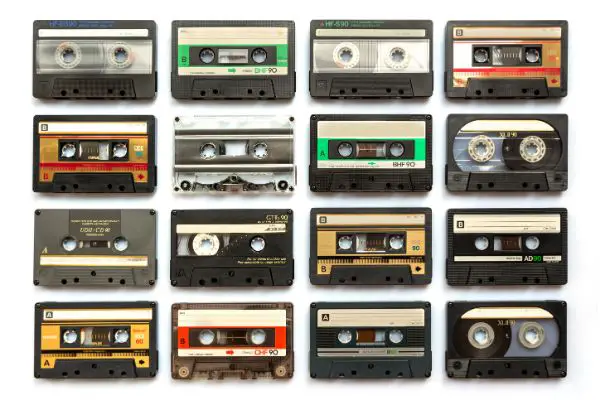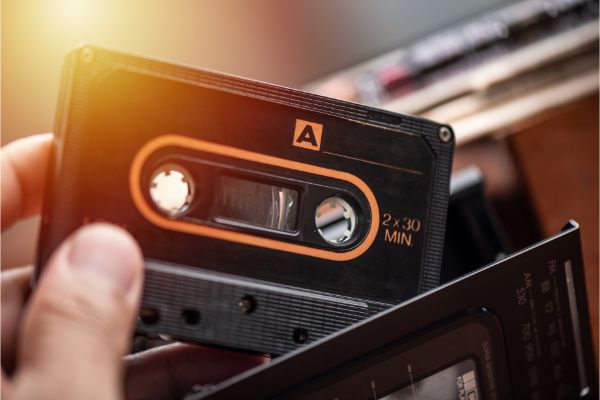Disclaimer: This post may contain affiliate links, meaning we get a small commission if you make a purchase through our links, at no cost to you. For more information, please visit our Disclaimer Page.
Cassettes are one type of physical media that we can use to store information. There are different types of cassette tape formats, but many of them operate on the same basic principles. Some formats can also store more than one type of media at once.
Although we use different technologies to store, read, or view most data in 2022, cassettes were once a standard that many industries would use for the same purposes. This is particularly true as cassette tape technology progressed over the years.
Just like modern computers today, researchers managed to refine and shrink the technology of the cassette tape down to smaller, more manageable forms. Whatever size a cassette may be, some people wonder just how they read the data that we can put on them. This is the central question that we will discuss in our article below.
Table of Contents
How Is Data Read Off of a Cassette Tape?
In short, cassette tapes use magnets and their fields in order to store and read data back to you. The entire process is somewhat more complex than this simple answer, however. If we take the example of music, the technology in a cassette tape, along with its recorder, turns sound waves into electrical ones. The devices that we use to record sound, such as microphones, also play a crucial role in this process.
For just reading the data that is already on the tape itself, a cassette uses a special head that has its own electromagnetic current. When you play a tape in any kind of device that can run it, spindles move the reel of tape past this head unit.
As the tape and the head make contact, the latter moves up and down in time with the charge that got to the tape when someone made a recording. In turn, the player translates this movement into waves. It can send these waves to other components in the device that will interpret them as sounds that come out of the speakers.
The above is a very general understanding of just how a machine can read data that someone already put on a cassette. Both the cassette and the machine use magnets and the processes that govern them in order to convert waves from one form to another. To better understand how the whole process works, we need to explore how a person or machine can get that data to go on a reel of tape in the first place.
Can You Store Data on a Cassette Tape?
For this section, we will focus on the kinds of audio tape cassettes with which many readers may be familiar already. Audio data is one of the most common types that various industries would store on cassette media in times past. In its basic form, a cassette is a plastic shell that contains a large line of tape.
Manufacturers wind this tape around two plastic reels that the plastic frame houses. Recording industries call one reel the supply one. They refer to the other reel as the takeup one. Furthermore, the tape component itself is also a form of plastic. Developers treat it with a magnetic coating that can react whenever it comes into contact with a field generating magnetism of its own.
When you set a cassette tape to record sound, special microphones into which you feed the sound include magnets of their own. This is true for microphones that you might talk or sing into, but certain instruments can also use microphone technology to help the cassette pick up the musical vibrations that they produce.
The vibrations go out into the surrounding air, and the magnets inside your recording device will pick them up. They do this because the tape goes along the magnetic field that the record head produces.
Earlier, we talked about how the tape spool itself has special coatings on it. These particles align themselves in particular ways that depend on how strong the field is as they pass through the head.
When you put audio out into the air as sound, the pitch and volume of what you produce determine how the particles on the tape align in a pattern. As such, you can record different sounds or music on a cassette tape. Once you play it, it will come out sounding like the audio you produced.
When you decide to play a cassette that has data you stored on it, the pattern of the particles stays the same as when you first put sound out into the air. This property is what allows you to rewind and play a tape as many times as you desire, and the hardware will keep the sounds the same each time. As physical media, tapes can and do wear out eventually over many playthroughs or years. There is also a way to expose a tape to a constant electrical charge that can reset the data on it for future recordings of different sounds.
How Many Songs Can Fit on a Cassette Tape?
The precise number of songs you can fit on one cassette can vary. However, this number usually depends on two main factors. Different formats of cassettes would hold different amounts of data.
Each side of a cassette can hold its own data. Once you finished one side, you could play the other. The lengths of each tape could vary according to the models a manufacturer would produce, but older cassettes had common lengths of 45 minutes of audio data per side. There are those that might be shorter or longer.
How many songs you can store on such a tape could also depend on the length of individual tracks. In the past, it was common for artists to make radio-friendly versions of songs that were no longer than three minutes in length. They did so as a way to comply with industry standards regarding song length.
However, some of their albums may have had other versions of the same songs that ran longer. If we take the radio length as a standard, you might fit as many as 30 songs on a single tape that uses both of its sides. This is just one example, however, and many tape-based albums could be shorter or longer.
Do CDs or Vinyl Records Hold More Data Than a Cassette Tape?
Typically, compact discs that meet the current industry standard are comparable to some of the common cassettes that stored data in the past. A CD-R format disc should be able to hold between 74 and 80 minutes of audio data. This is just shy of what a standard cassette holding 90 minutes might produce. It is possible that a particular CD-based album might hold as many songs as a cassette, however.
Vinyl records predate both of these technologies. Just like CDs or cassettes, there were different formats that manufacturers could create. When vinyls were popular, studios would measure them according to physical size and the RPMs at which they would spin on the player. Therefore, one common standard was the 12-inch vinyl record at 45 RPMs. If we use this standard, the vinyl can hold an estimate of about 15 minutes of data on each of its sides. In total, it could hold around 30 minutes of data. This makes its storage capacity smaller than either of the two other standards we are discussing here.
Do CDs or Vinyl Records Sound Better Than Cassette Tapes?
Yes, both compact discs and vinyl records tend to sound better than cassettes. There may be some exceptions here, but the properties of the former two formats allow them to preserve sound quality better than cassettes can.
This is one of the biggest reasons why the tapes might sound worse than other audio storage formats. Cassettes tend to have some noticeable background noise that can interfere with the quality of the sound you hear.
Additionally, compact discs have some potential to preserve the original sound that an artist records in a lossless way. This means that the sound you hear should be a close representation of what the waves produced when the recording process took place. Part of this is because discs do not have any tolerance for distortion. The discs also have a higher dynamic range than their vinyl counterparts.
Conclusion
Cassettes can store what we might think of as small amounts of data today. One of the most common forms that data takes for this storage medium is audio. Magnets and their fields help cassette technology to translate waves into audio you can store and play back at your leisure. However, the format has some quality limitations when you compare it to other storage types that can save audio for you.


